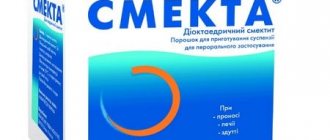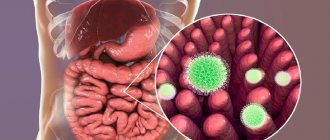Main causes of abdominal pain and diarrhea in children
Discomfort in the abdominal area and diarrhea are usually caused by infectious diseases, pathologies of the gastrointestinal tract, or poor nutrition of the child. Depending on the cause of the baby’s poor health, the corresponding clinical picture develops.
Infections
The stomach may hurt and twist due to the presence of the following diseases:
- Dysentery. The infection enters the human body by consuming contaminated food. Children under 4 years of age are most susceptible to the disease (60% of the total number of patients). Dysentery begins with abdominal cramps and loose stools. The disease is often accompanied by fever, chills, and general weakness.
- Rotavirus infection. Mostly affects children aged 6 months to 2 years. The main symptom of infection is severe vomiting. Diarrhea also develops, there is a fever, and the stool becomes yellowish.
- Salmonellosis. The disease develops due to consumption of contaminated food - eggs, meat, milk, cheese. Symptoms: frequent watery stools, nausea, vomiting, abdominal cramps, headache, fever.
The main danger of intestinal infections for children is the high risk of dehydration. This condition provokes serious neurological disorders and heart failure.
Gastrointestinal diseases
If diarrhea and abdominal pain appear, the development of gastroenteritis can be suspected. In the presence of this disease, inflammation of the mucous membranes of the stomach and small intestine occurs. The pathology is also accompanied by weakness, vomiting and nausea, and mucus is found in the stool. A feature of gastroenteritis is that it is provoked by other diseases. Inflammation is caused by parasitic infections, pancreatitis, cholecystitis.
Dysbacteriosis is also the cause of the development of loose stools in combination with pain. Pathological changes in the intestinal microflora occur due to the use of antibiotics and poor diet.
Acute appendicitis no less often leads to diarrhea and severe pain localized on the right side. This condition may be accompanied by an increase in body temperature, the child refuses to eat and becomes lethargic.
Poor nutrition
If you give your baby too fatty, heavy food that is not appropriate for his age, digestive upset occurs. It is accompanied by frequent bowel movements, nausea, abdominal cramps, and possibly a slight increase in body temperature. At the same time, the child remains active and does not feel weak.
Unpleasant symptoms may also appear due to overeating or eating heavy food before bed. Similar disorders are often encountered by infants who have recently been introduced to complementary foods. Diarrhea and colic are explained by the body's reaction to a new product.
Causes
The disease can be caused by dangerous intestinal infections, dysbiosis, and intolerance to certain foods. If the cause of poor health is an infection, then diarrhea may be accompanied by fever. There are several dangerous diagnoses in which a child develops diarrhea and a tummy ache.
A baby may experience abdominal pain due to the mother’s diet being disrupted. Inflammation may develop in the walls of the digestive tract, which causes stool upset. Loose stools are often caused by overeating and mistakes when introducing complementary foods. The stomach cannot withstand heavy loads when consuming large amounts of food or low-quality products.
Black stool indicates intestinal bleeding and requires an immediate call to the ambulance. In this condition, one-time or frequent vomiting may occur. This is how the body tries to cope with harmful toxins and cleanse itself of dangerous substances. It is important to know that vomiting in case of poisoning is a natural reaction of the child’s body and its defense mechanism against the negative effects of infections.
On a note! Nausea, vomiting and diarrhea can be caused by medications. Non-steroidal anti-inflammatory drugs especially have a negative effect on the gastrointestinal tract.
Dyspeptic diarrhea can occur due to a lack of certain liver and pancreatic enzymes. In other cases, the cause of diarrhea is infections and diseases of the digestive system.
Warning signs
It is recommended to immediately consult a doctor if the following clinical picture develops:
- the appearance of blood impurities in vomit or feces;
- frequent loose stools – more than 8-10 times a day;
- incessant vomiting;
- rapid increase in body temperature;
- a significant deterioration in the baby’s well-being in a short period of time;
- the appearance of vomiting, diarrhea, and abdominal pain in children under one year of age.
Komarovsky points out that urgent medical intervention is also necessary if signs of dehydration develop. These include dry skin and mucous membranes, sinking of the fontanel, and a decrease in the number of urinations. The development of dehydration is indicated by severe weakness and drowsiness of the child.
When to see a doctor
If your child has diarrhea and severe stomach pain, be sure to contact your local doctor or call an ambulance. Particularly dangerous phenomena:
- The pain was first localized in the epigastric region, then moved to the right iliac region. This may be associated with the development of appendicitis. If in this condition in adults, bowel dysfunction occurs once or the disease is accompanied by constipation, then for children repeated diarrhea and pain are a typical phenomenon. Don't waste a minute, quickly seek qualified help.
- Poop gives off a strong, unpleasant odor.
- Diarrhea does not stop throughout the day, the child has become lethargic, severe dehydration and hypovolemic shock are observed. Typical signs of such conditions are dry skin, the skin fold takes a long time to straighten, the baby is generally inaccessible to contact or is constantly sleeping and does not regain consciousness.
- The presence of pathological impurities in the stool (pus, blood, mucus) may directly indicate pathology of the colon (Crohn's disease, ulcerative colitis, internal bleeding). Pay attention to the color of the stool (green may indicate a disease of infectious etiology).
- The child began to have seizures.
- The pain syndrome is not relieved by painkillers.
- The temperature reaction is observed for several days.
Diagnostics
When alarming symptoms appear, the doctor examines the child and studies the developing clinical picture. To determine the severity of the baby’s condition and the causes of the illness, a number of laboratory tests are prescribed:
- general blood analysis;
- urine test (including for diastasis);
- coprogram;
- blood biochemistry;
- examination of biological fluids for the presence of infectious pathogens.
Sometimes the child is sent for ultrasound diagnostics of internal organs. In severe cases, an MRI is done.
Dysentery
The disease is especially common in the warm season. The reason the infectious agent enters the child's body is the consumption of unwashed foods. Children are especially susceptible to the influence of harmful bacteria due to their underdeveloped immune system. If your baby has eaten several unwashed fruits during the day, by the evening he may well feel sick. Children under 3 years of age are most susceptible to pathogenic bacteria.
The cause of the disease can also be unfavorable conditions - poor personal hygiene, untimely hand washing, drinking contaminated water and dirt in the room. In such cases, pathogenic microbes enter the digestive tract and cause disruption of its functions. Diarrhea and cramping pain in the abdomen occur. The incubation period of dysentery lasts from 1 to several days.
Main symptoms of the disease:
- Fever;
- pain in the iliac abdomen;
- feces with mucus and blood streaks;
- severe diarrhea;
- green liquid stool;
- rumbling in the stomach;
- vomit.
With dysentery, there is an acute onset of the disease, which causes very frequent loose stools. With diarrhea and abdominal pain, the child may have a false urge to defecate, which leads to rectal prolapse. Vomiting occurs, severe intoxication of the body, and general weakness is observed.
Know! Only a pediatrician or infectious disease specialist can determine an accurate diagnosis. To identify the causative agent of the disease, blood and stool tests are taken, and sigmoidoscopy is performed.
Treatment of the disease comes down to strict adherence to bed rest and taking medications prescribed by the doctor. Treatment with antibacterial drugs is carried out, measures are taken to eliminate dehydration in the child, and a special diet is prescribed. Treatment can take place at home or in an outpatient setting.
First aid
If your child has diarrhea, you should consult a doctor. Until a specialist has examined the baby, he should be placed on bed rest. It is undesirable to feed the child; this can further aggravate the situation. It is recommended to offer plain water or special pharmaceutical solutions (Regidron, Oralit) often, but in small portions, to prevent dehydration.
You can prevent the worsening of intoxication with the help of enterosorbents - Smecta, Enterosgel, Polysorb. To normalize body temperature, use Paracetamol and Ibuprofen. Giving a child painkillers or drugs to reduce intestinal motility (Loperamide, Imodium) is strictly prohibited.
First aid
- When your stomach hurts, the first thing you need to do is get bed rest.
- In case of poisoning, first aid is limited to gastric lavage, which prevents the absorption of harmful toxins into the blood.
- A weak solution of manganese or a solution of table salt is used. The liquid prepared for gastric lavage should be given to the child to drink. Up to 3 years of age, the procedure is best performed using an isotonic NaCl solution.
- To remove toxins, sorbents such as Enterosgel and Smecta are used.
If vomiting is observed, it is necessary to provide the baby with frequent drinks in small portions. To restore the water-salt balance in the body, Regidron and Hydrovit solutions are used. It is necessary to drink weak tea, fruit drinks, compote.
For dysbacteriosis, probiotics are used that restore the microflora of the gastrointestinal tract - Bactistatin, Linex. For stomach pain, drinking chamomile infusion helps a lot. Medicines such as Imodium and Loperamide will help eliminate diarrhea and reduce intestinal motility.
Therapy methods
In case of severe disease, the child is placed in a hospital, but outpatient treatment is also possible. The list of techniques used depends on the presumptive diagnosis and developing symptoms.
Drug treatment
The following drugs are used to treat children with intestinal disorders:
- Antibiotics, antiviral, antifungal agents. A specific drug is prescribed to which the pathogenic microorganism is sensitive.
- Sorbents. They absorb harmful substances and remove them from the human body; they are not absorbed into the systemic bloodstream.
- Antispasmodics. Used to relieve spasms in the intestines, which leads to the elimination of pain.
- Enzymes. Used in cases of dysfunction of the pancreas to improve the process of digestion of food.
For diarrhea and abdominal pain without fever in children, medications are used to normalize the intestinal microflora. Probiotics increase the number of beneficial bacteria, which leads to improved well-being for the baby.
Traditional medicine recipes
As an auxiliary therapy for intestinal disorders, the use of medications prepared using herbs is allowed:
- Dill water. A teaspoon of fennel seeds is poured into 230 ml of boiling water. After 40 minutes, filter the infusion. It can be taken several tablespoons per day.
- Rice water. A tablespoon of cereal is infused in cold water for 20 minutes. The washed rice is poured with 200 ml of boiling water and cooked over low heat for 40 minutes. The resulting liquid is taken in small portions until the stool normalizes.
- Potato broth. For treatment, use the liquid that remains after cooking the vegetable. It is taken instead of water to relieve diarrhea.
Intestinal disorders can be treated with mint tea. At the same time, it has a slight sedative effect.
Salmonellosis
The infection is often transmitted through domestic animals. Salmonella enters the gastrointestinal tract and causes loose stools in the child. Infection can also occur from infected adults, or after eating contaminated food. A newborn can get salmonellosis from maternity hospital staff.
Symptoms of the disease:
- Foul-smelling bloody diarrhea with pieces of undigested food;
- heat;
- poisoning of the body with toxic substances;
- dehydration;
- nausea;
- bloating;
- rumbling when palpating the abdomen.
The disease is diagnosed after examining a tank of feces and vomit. If a child has a stomach ache and diarrhea, then all prescribed tests must be taken. The examination will help prescribe the correct treatment, which will quickly remove harmful toxins from the body. In case of illness, broad-spectrum antibiotics are taken, and drug therapy is prescribed to eliminate dehydration.
Possible complications
The most common negative consequence of intestinal disorders in children is dehydration. In babies under one year old, this condition develops within several hours after the first symptoms of the pathology appear. In the absence of proper medical care, dehydration leads to irreversible consequences for the body.
There is a possibility of developing infectious-toxic shock. This condition is characterized by a significant increase in the concentration of blood toxins, which leads to hemodynamic disturbances. Other complications that occur in children include the development of pneumonia and acute renal failure.
Diarrhea symptoms
The frequency of stools with diarrhea varies, and stools are watery or mushy. The nature of bowel movements depends on the disease. So, with dysentery, the feces first have a dense consistency, then become liquid, scanty, mucus and blood appear in it; with amebiosis - contains glassy mucus and blood, sometimes the blood permeates the mucus and the stool takes on the appearance of raspberry jelly. With diarrhea, there may be abdominal pain, a feeling of rumbling, transfusion, and bloating. Finally, rectal colic, or so-called tenesmas, may occur. They are manifested by frequent and painful urge to go down with a feeling of convulsive contraction of the rectum and its sphincter; defecation does not occur, but sometimes lumps of mucus may be released. Mild and short-lived diarrhea has little effect on the general condition of patients; severe and chronic diarrhea leads to exhaustion, hypovitaminosis, and pronounced changes in organs.
Preventive measures
To prevent your child from developing conditions that are dangerous to his health, you must follow simple rules:
- Before eating, after visiting the street, toilet, public places, you should wash your hands thoroughly;
- it is advisable to prevent the child from contacting people with signs of intestinal infections;
- The baby should have separate dishes and cutlery;
- for cooking it is important to choose high-quality products with a normal shelf life;
- To strengthen your child’s immunity, you should often take him for walks in the fresh air.
To prevent the development of rotavirus infection in children, vaccination is carried out. It is carried out in 2-3 doses with a minimum interval of one month. Vaccination begins at 6 weeks of age.
How to determine the cause by symptoms
If a child has a stomach ache and diarrhea, this may be a sign of:
- Intestinal pathologies. The pain is cramping in nature.
- Ulcer. Pain appears 1-2 hours after eating.
- Appendicitis. In some cases, when intestinal motility is impaired, attacks of appendicitis may be accompanied by diarrhea.
If a child has a stomach ache, diarrhea and increased body temperature, the reasons may be as follows:
- Intestinal infections. Viruses, once in the digestive tract, cause all the symptoms of intoxication of the body. The child has severe stomach pain, very frequent diarrhea, and possible dehydration.
- Dysentery. With this disease, the pain is cramping in nature, severe diarrhea appears, and the temperature can rise to 40 degrees.
Diarrhea can be accompanied not only by pain, but also by vomiting.
Most often, the cause of such symptoms is food poisoning and enteritis. In case of poisoning, the speed at which the first signs appear depends on what caused the intoxication. Symptoms may appear after 12 hours or even after half an hour in cases of chemical poisoning.
With enteritis, the most common symptoms are diarrhea, vomiting and weakness.











